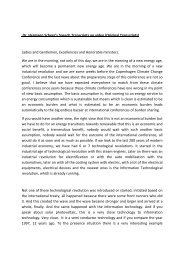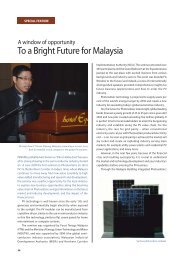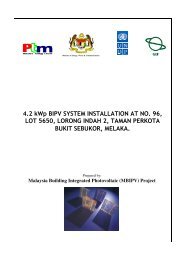MBIPV Project Brief
MBIPV Project Brief
MBIPV Project Brief
Create successful ePaper yourself
Turn your PDF publications into a flip-book with our unique Google optimized e-Paper software.
product performance will be established to ensure the quality and reliability of the localmanufactured products, and to increase the level of expertise for the R&D and industry sectors.BENEFITS OF THE PROJECTGLOBAL BENEFITS64. Additional coal and gas-fired power plants are planned to be on-stream by 2010 to meet systempeak demand, which is expected to increase from 10 GW (2000) to 22 GW in 2010 in PeninsularMalaysia. These additional conventional power generator units will emit an additional 34 milliontons CO 2 (coal) and 8 million tons CO 2 (gas) per year starting from 2010. This will lead to atremendous increase in GHG emissions, causing more serious problem to the globalenvironment.65. The <strong>MBIPV</strong> <strong>Project</strong> is expected to generate widespread BIPV replication via the National BIPVProgram within the 10th and subsequent Malaysia Plans. The potential BIPV installed capacity isabout 20 MWp by year 2020. Over a lifetime of 25 years, the operation of the 20 MWp BIPVwould result in the avoidance of CO 2 emissions equivalent to 34,720 tons CO 2 per annum thattranslate to 868,000 tons CO 2 over the PV lifetime period of 25 years. The potential of global andregional benefits are substantial, as the outputs of this GEF supported project will be shared withneighboring countries. It is anticipated that due to the replicability of the project, identicalprojects will be implemented in other ASEAN countries, contributing to further reduction ofglobal GHG emissions. An initial assessment on market potential identifies a possibility of 200MWp installed capacity for the ASEAN and Pacific region, contributing to a reduction of CO2emissions equivalent to 340,000 tons per year.NATIONAL BENEFITS66. Malaysia has one of the fastest growing building sector world-wide, where the energy demandwill significantly increase in the next coming years. The available building spaces (facades androofs) offer significant untapped potentials for PV application in buildings. BIPV serves dualpurposes, as a building element and as an electricity generator. Considering the synergies andbenefits of BIPV application, the technology will have an important and sustainable impact to thebuilding market, and will be able to substitute part of the conventional gas-fired peak electricitygenerators. Yet, these benefits remain largely untapped. Phasing in PV therefore requires a shiftfrom centralized to decentralized power production.67. Grid-connected BIPV applications provide multitude benefits for Malaysia. The ability of the PVsystem to generate electricity close to the point of consumption ensures that transmission anddistribution losses are kept to a minimum level, thereby promoting energy efficiency. The utilitycould gain the most benefit through the associated reduced financial risk. Installations of BIPVby the public do satisfy a portion of the peak demand. Furthermore, the utility will not have tobear those capital costs and could defer a portion of the investment of future peak powergenerators. More importantly, the utility will be able to reduce the dependence on natural gas asthe peak fuel resource. In any case, the most important benefits of BIPV, especially in urbanareas, will be the opportunity to utilize PV technology without the need of land-use. As the costof land is significant in urban areas, BIPV will allow the utilization of PV technology to generateelectricity without incurring the additional cost of land-use.20















